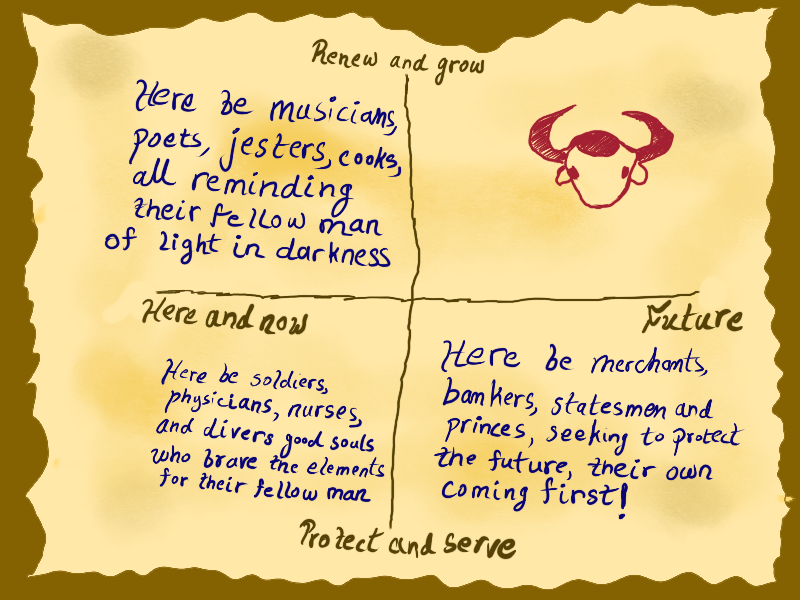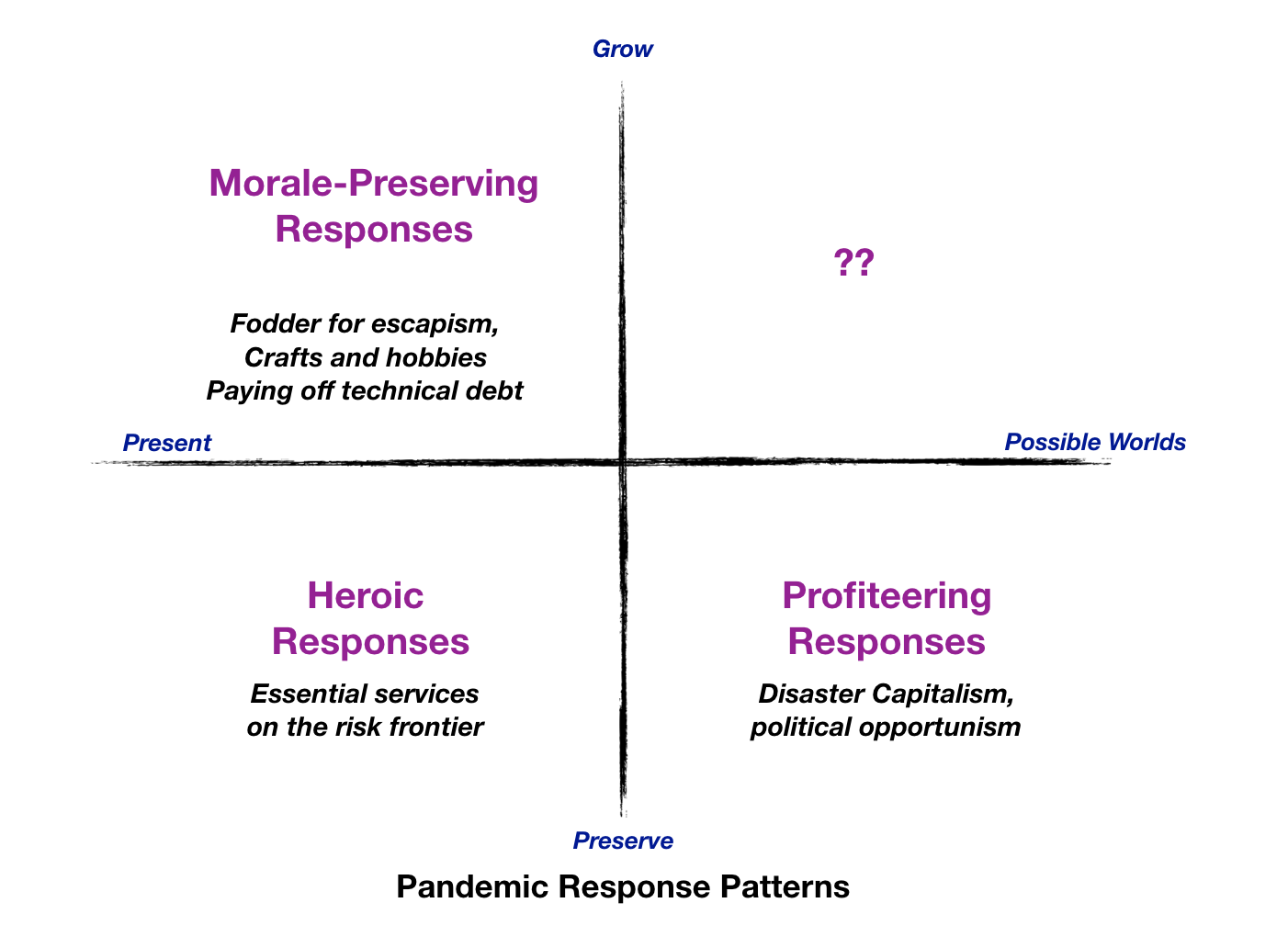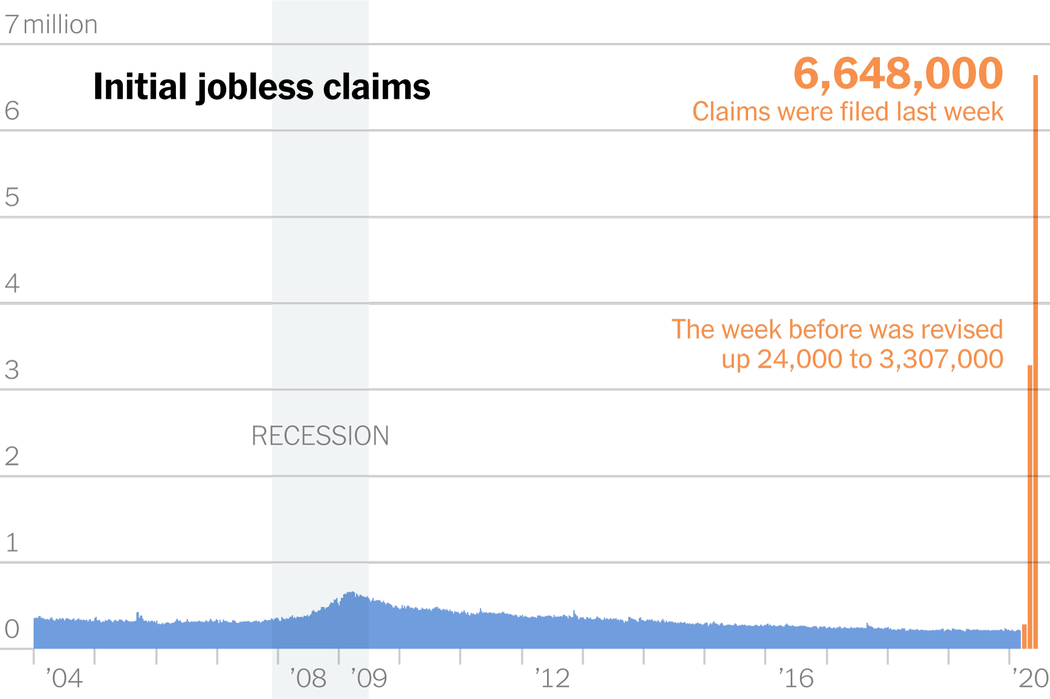You’ve probably noticed that in the past month or two, this newsletter has been increasingly hijacked by not one, but two kinda off-topic threads. The first is of course the Covid19 pandemic which is hijacking every conversation in sight. The second is the indie community bootstrapping effort that I, along with a few other indies like Tom Critchlow, Paul Millerd, and Pamela Hobart, have been working on.
I’m happy to report that the later persistent hijacking has now evolved and matured into Its Own Thing.™
Introducing the Yak Collective, and its first collaborative project, a report titled Don’t Waste the Reboot, with contributions from 21 independent consultants, and additional support from nearly half a dozen others.
Paul Millerd led the effort, and the process of pulling it together was as enlightening as thinking through the content itself.
Take a browse, explore the deck, and share/signal boost as you think it deserves to be. If you have the ability to do so, take it out fishing in executive-suite land, and bring us back a gig on the strength of the deck.
A big thank you to all who contributed, not just to the content, but to the process of pulling it together, and building out the just-in-time infrastructure required to get it out there. “Open-source” style output often lacks the finish and polish of commercial stuff, and that applies to open-network emergent indie collaborations as well, but in this case, we solved that problem — people volunteered for everything from proof-reading to sizing images correctly.
I’m particularly proud of the sheer speed with which we managed to pull this together. From inception to delivery, this deck, and the website/distribution infrastructure to put it out there, took about 2 weeks.
It’s one thing to claim that indies operate on a faster, more responsive OODA loop than big organizations, but another thing to actually demonstrate this.
Can indies turn into the special forces of sense-making and rapid action in the post-Covid world? I think we can. That’s what I want to talk about tomorrow morning, so let me tee up that discussion.
Town Hall
Tomorrow morning, at 9 AM Pacific, the usual time I host a Discord chat, I will host a special edition, longer, one-hour chat open to all who care to join in — a town hall to talk about this first project launch, and where we go from here. So make sure to join in.
To tease what I have on my mind to talk about tomorrow, here’s the thought-starter: If we can keep up the kind of tempo that drove our first project, while increasing the complexity and ambition of our collaborative efforts, indies can easily turn into the special forces of consulting — able to get off the ground faster, do our sense-making faster, analyze and synthesize faster, and deliver serious intelligence and output to the world while larger organizations are still holding endless meetings, lost in the FUD.
How can indie teams competing with traditional orgs deliver output that’s twice as good in half the time?
That, I think, is the challenge we face, and the reason I personally have been investing time in getting this thing going.
To that end, for those of you want to join this effort, here’s your chance to get in on the ground floor — a call for proposals, which I’ll talk more about on the chat tomorrow.
6 Reports in 6 Months: Call For Proposals
In the next 6 months, we hope to do a Yak Wisdom series of Covid19 themed collaborative projects like Don’t Waste the Reboot, using the pooled resources of the Yak Collective. The idea is to grow a network of indies who are connected not just through casual social network links, but through a shared history of working together on meaningful things.
We’re already underway — 21 of us are linked via co-authorship links on this first report, and have developed a certain amount of trust in each other.
So to get that going in a bigger way, we’re issuing a call for proposals. Check out the Yak Collective Collaborations page on our Roam database.
There’s a link to a proposal form there where you can submit a proposal, as well as a list of thought-starter ideas if you need inspiration. Join the Discord, chat with me or one of the other partners (Paul, Tom, Pamela), sound out potential contributors via informal conversations, and submit a proposal.
The deadline for proposals is Friday, May 8th.
Our goal is to put out a report a month for the next 5 months, all broadly on the Covid19 theme, to build up a solid repository of reboot intelligence for organizations of all kinds. We’ll figure out some collective way to prioritize the ideas to work on — maybe something as simple as green-lighting the ones that attract the most contributors.
I’d like to particularly encourage those who contributed to the first project to consider proposing and leading one. Compound interest is a powerful thing, and I’d like to get that particular learning loop iterating as quickly as possible in our little fledgling network. The more of these efforts a single contributor participates in, the smarter the network gets about such efforts.
Right now, only Paul Millerd has learned how to pull one of these indie collaborations together. I’d like a dozen of us to have acquired that know-how in 6 months.
We have to initially limit output to a report a month simply because our shared ability to market and disseminate work like this is still pretty limited (it’s a bunch of us with newsletters and social media followings/existing clients). To be honest, even one a month seems like an ambitious stretch goal to me at this point.
So we want to build up momentum slowly. If we can put out 6 reports in 6 months, each better than the last, people will sit up and take notice, and good things will start to happen for all who participate.
Slow is smooth, smooth is fast, as the special forces saying goes.
If we want the indie world to turn into the special forces of sense-making, we’re going to have to actually operate that way.
Why Do This?
It might not be clear to some of you, especially if you haven’t been in the indie game very long, why it is a good idea to attempt this marathon of 6 reports in 6 months.
Building up a track of internally generated collaborative activity like this will, I suspect, address the single biggest thing that prevents independents from going after larger gigs and projects — a proven ability to assemble larger teams with varied capabilities.
This is an area that I myself have significant learning ahead of me. The most collaboration I’ve ever done on gig work is with 1-2 other subcontractors, and for a few months at most. By contrast, back when I had a paycheck job at Xerox 10 years ago, I was leading a great team of 10-12 people for nearly 3 years straight.
I honestly have no idea how I’d pull together a 12-person/3 year team for a larger project out of a loose network like the Yak Collective, while still operating by a model that is still essentially indie in spirit, with its ethos of people working on their own time with very low mutual-dependency levels. It will be hard to do that without defaulting to the old ways developed by paycheck organizations and reproducing their well-known failure modes. If we’re going to fail at this sort of thing, I’d at least like to fail in new ways.
It’s not going to be easy to have our cake and eat it too — retain that sense of individual freedom that attracted us to indie work in the first place, while realizing the benefits of working in larger free-agent teams on larger projects.
But I’d like to learn this game, and give the paycheck consulting crowd a run for its money. As I’m sure many of you would too.
And once we address that weakness around building larger teams, our natural strengths — diversity, speed of sense-making, loose synchronization, true variety of capability, improvisation ability — will kick in.
But there’s a larger principle here. Not only can we attempt this, in a sense we must attempt this. Here’s why.
How Can Indies Not Waste the Reboot?
Our first deck has launched with the title Don’t Waste the Reboot. If you’ve been participating in the community, or contributed, think about that for a second.
That advice applies, first and foremost to us, the ones presuming to give it to others. How can we make sure that we don’t waste the opportunities being created by this crisis to advance the interests and capabilities of the indie sector?
It’s not a cynical disaster-capitalism type question. It’s not about profiteering.
I think most of us genuinely believe that the indie sector is a force for good in the world, bringing speed, variety, diversity, dissent, unique capabilities, alternative value orientations, and other good things, to a monocultural institutional world that sorely needs all of those things in spades.
So yes, we have to ask ourselves first, how do we not waste the reboot?
The tagline of our first report is “Making the next normal better than the last one” and again, by the dog-food principle, if we aren’t able to take that advice ourselves, what exactly are we doing peddling it to others?
So the next normal for the indie consulting sector should not be the same as the old normal. What does that mean?
-
It shouldn’t be limited to small 1-2 person table-scraps projects on the margins of bigger, more consequential projects.
-
It shouldn’t have to struggle for the attention of leaders in organizations driving the most interesting work around the world.
-
Bringing on teams of indies shouldn’t fail for stupid reasons like not having the ability to set up the necessary webs of subcontracts, insurance policies, and NDAs, or managing the payment distribution logistics. Those transaction costs need to go down.
-
Bringing on a team of indies should be the first thing an executive thinks of when faced with a new kind of challenge, not the last resort. New problem, new people. Why isn’t the calculus as simple as that? It should be.
How do we make these sorts of things happen? Let’s figure it out, one collaborative effort at a time, one conversation at a time, one attempt to pitch a team project at a time.
That’s what I hope the Yak Collective will be about, at least to the extent I have had a hand in shaping it.
A New Praxis for Indie Work
Not wasting the reboot as indies means thinking harder about every aspect of how we operate, from philosophy to low-level tools and tactics.
I talk about both a lot in this newsletter — as do my fellow instigators of the Yak Collective in their writings — but for the next-level thing we’re attempting here, those ideas have to evolve from talk and “advice porn” to a larger praxis — an attempt at situated, philosophical practice.
We’ve already put some effort into laying out our philosophy on the About page. It’s not the usual yada-yada-contact-us boilerplate. So check it out.
But that’s just starter thoughts that occurred to us in the process of pulling this first project together. The real work of figuring out a reimagined praxis of indie work for the post-Covid world is going to be done in the conversations around actually trying to do different kinds of work.
And doing it in different ways, through open-network modes, like the Yak Collective is trying to do.
Eating our own dog food as indies is not about doing philosophy, but about doing philosophically. It’s not about debating manifesto points, but about mindful reflection on work being done and shipped. Rough consensus and running code, applied to gig work collaboration.
So let’s not the waste the reboot. Let’s make sure the next normal is better than the last one — for indies. By starting to work differently now and learning from it.
What might happen if we succeed?
Back in the 1950s they used to say, what’s good for GM is good for America. It was a positive sentiment about the worth of big paternalistic companies that eventually turned into a satirical line.
I’d like people to start saying: what’s good for indies is good for the world — but intend it sincerely rather than satirically.
That’s my personal success metric here.
And I hope the Yak Collective is not the only effort of its kind to emerge in the post-Covid world.
I for one would like to see dozens of such experimental efforts sprouting up around the world, trying out new ways of working within the free-agent economy, and new patterns of relating to the paycheck economy.
Most such efforts will fail. Most, but not all.
New entrants to the indie economy in 2025 will enter a different, better indie economy than I did in 2011. Because at least a few experiments starting right now will work out, and then the next normal won’t be like the last one.
Where to Now?
You can follow the progress of the Yak Collective on Twitter, Facebook, or LinkedIn. I’ll continue to highlight interesting developments selectively here, as will the others involved, on their newsletters/blogs etc.
As most of you know from the last few newsletters, there’s a knowledge base built on a Roam database, and a Discord community with several hundred people. We’re slowly building out more infrastructure, as people step up to build out bits and pieces of what we need to be effective.
A fledgling community building effort like this will of course continue to require significant TLC and stewardship from all involved, especially from those of us who instigated it, so I expect to continue talking about the Yak Collective and its work from time to time on this newsletter.
We’re past the hijacking stage, since the project is now starting to take its first wobbly steps on its own, but it will be a while before it becomes sentient, turns into the Indie Skynet, and takes over the world.
I haven’t yet decided how I will be weaving in the community stuff with my own writing, but I’ll figure something out.
Those of you who are primarily here for my writing, you’ll be able to tune out the Yak Collective stuff if you want.
Those of you who are interested in the Yak Collective, and my piece of that activity stream, you’ll have ways to tune in to that too.
Even at the level of this email newsletter, I’m trying not to waste the reboot myself. So yes, there’s a small pivot going on here, but I hope most of you will decide to stay with me through it.
We’ll be back to regular Art of Gig programming next week. No doubt my participation in the Yak Collective will shape some of the topics I cover here. For example, I already have a LOT of thoughts on how to make larger indie collaborations on gigs happen, so I’ll be writing about that. And of course, this whole effort has inspired a lot more ideas for me for Yakverse stories, so there will be that too.
Strap in. Interesting times dead ahead.
And don’t forget — browse and signal-boost Don’t Waste the Reboot, follow us on Twitter, Facebook, or LinkedIn, join in for the Discord chat tomorrow morning, and consider submitting a proposal for our Yak Wisdom series.







